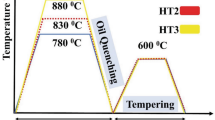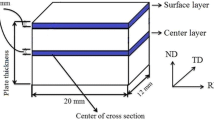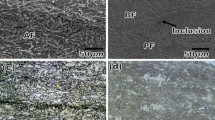Abstract
Studies to date have not completely determined the factors influencing hydrogen embrittlement of ferrite/bainite X80 pipeline steel. Hydrogen embrittlement susceptibility was evaluated based on fracture strain in tensile testing. We conducted a thermal desorption analysis to measure the amount of tracer hydrogen corresponding to that of lattice defects. Hydrogen embrittlement susceptibility and the amount of tracer hydrogen significantly increased with decreasing crosshead speed. Additionally, a significant increase in the formation of hydrogen-enhanced strain-induced lattice defects was observed immediately before the final fracture. In contrast to hydrogen-free specimens, the fracture surface of the hydrogen-charged specimens exhibited shallower dimples without nuclei, such as secondary phase particles. These findings indicate that the presence of hydrogen enhanced the formation of lattice defects, particularly just prior to the occurrence of final fracture. This in turn enhanced the formation of shallower dimples, thereby potentially causing premature fracture of X80 pipeline steel at lower crosshead speeds.







Similar content being viewed by others
References
B. Saleem, F. Ahmed, M. Asif Rafiq, M. Ajmal, and L. Ali, Eng. Fail. Anal. 46, 157 (2014).
B.T. Lu, J.L. Luo, and P.R. Norton, Corros. Sci. 52, 1787 (2010).
P. Liang, X. Li, C. Du, and X. Chen, Mater. Des. 30, 1712 (2009).
Z.Y. Liu, X.Z. Wang, C.W. Du, J.K. Li, and X.G. Li, Mater. Sci. Eng. A 658, 348 (2016).
K. Takai, H. Shoda, H. Suzuki, and M. Nagumo, Acta Mater. 56, 5158 (2008).
T. Doshida, M. Nakamura, H. Saito, T. Sawada, and K. Takai, Acta Mater. 61, 7755 (2013).
T. Doshida and K. Takai, Acta Mater. 79, 93 (2014).
T. Neeraj, R. Srinivasan, and J. Li, Acta Mater. 60, 5160 (2012).
C. Hwang and I.M. Berstein, Acta Metall. 34, 1001 (1986).
H. Shoda, H. Suzuki, K. Takai, and Y. Hagihara, ISIJ Int. 50, 115 (2010).
H. Qiu, H. Mori, M. Enoki, and T. Kishi, ISIJ Int. 39, 358 (1999).
P. Fassina, F. Bolzoni, G. Fumagalli, L. Lazzari, L. Vergani, and A. Sciuccati, Proc. Eng. 10, 3226 (2011).
M. Wang, E. Akiyama, and K. Tsuzaki, Scr. Mater. 52, 403 (2005).
T. Doshida, H. Suzuki, K. Takai, N. Oshima, and T. Hirade, ISIJ Int. 52, 198 (2012).
R. Mastumoto, N. Nishiguchi, S. Taketomi, and N. Miyazaki, J. Soc. Mater. Sci. Jpn. 39, 182 (2014).
Author information
Authors and Affiliations
Corresponding author
Rights and permissions
About this article
Cite this article
Hattori, M., Suzuki, H., Seko, Y. et al. The Role of Hydrogen-Enhanced Strain-Induced Lattice Defects on Hydrogen Embrittlement Susceptibility of X80 Pipeline Steel. JOM 69, 1375–1380 (2017). https://doi.org/10.1007/s11837-017-2371-1
Received:
Accepted:
Published:
Issue Date:
DOI: https://doi.org/10.1007/s11837-017-2371-1




